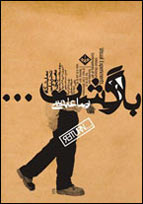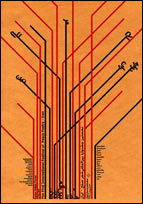Practicing in his homeland of Iran, Reza Abedini is an accomplished graphic designer who continually blurs the lines between art and design. He combines simple illustrations with poetic typography and elegant layouts, exploring the beauty of the Persian language. As well as being a member of the AGI, Abedini has won many awards as well as judged and been apart of many panel discussions.
“For me, graphic design is totally art”
“For me, graphic design is totally art.” Looking at the work of Iranian graphic designer Reza Abedini this is easily an understandable comment. With a strong sense of pride in his Islamic heritage and Iranian background, Abedini wields his skills with the Persian Language in beautiful and graceful ways. With a strong passion for the history of his culture, Abedini believes that traditional art forms are dead and that “graphic design is a new art of the 20th [and] 21st century … Graphic design is a kind of phoenix”. Looking at his posters, free of the influences of the International Style, you can’t help but feel that you are looking at a piece of art as much as you are looking at a piece of graphic design — the lines of both being deliberately blurred in an effort to speak with his own voice as a director speaks with theirs when reciting a screenwriters script.
“Graphic design is a kind of phoenix”
A helping hand
As a teenager Abedini was guided into the arts by the hand of a teacher who saw a creative spark in his pupil. He requested a short story from Abedini. Finding favour with his teacher, this short story caused him to see fit to ask Abedini to assist him with various creative projects. With a way to travel into the world of creative thinking, Abedini’s knowledge of the crafts began to expand.
Abedini enjoyed this time of creative flourishing and exploration, eventually hitting a chord with brush and paint. An interest ignited when he was tasked with illustrating the set for the play his school was performing. His teacher, once again seeing something in Abedini, introduced him to graphic designers and other creatives in the area, who served as a gateway to deeper knowledge of the world of creativity, as well as Iranian and Persian cultural history.
He went on to study the art of the brush and pigment, as well as print-making, all while unsure of what avenue he ultimately wanted to travel down. Although the start of his studies at University generated a lot of excitement and interest in the world of graphic design, it wasn’t until he started to have his name spread around by those who commissioned his artworks that graphic design came up as an option as a professional career. Some of his clients for whom he painted began to request his skills to be used for graphic design projects.
With no formal graphic design education,
he had to rely on what he knew about expressing creativity
And it is here that the style of Reza Abedini can be found in its infancy. With no formal graphic design education, he had to rely on what he knew about expressing creativity to produce an outcome that could be considered graphic design.
So he combined what he knew — the self expression of the art world, print making and, most passionately of all, typography and lettering.
While in his youth there were restraints in place by religious and political power figures that restricted access to the outside world – rather than looking at the culture of others of the present, he and his peers had to look at the culture of theirs of the past. This is when his passion for Persian calligraphy and typography was planted, something he could now explore in a direct manner through graphic design.
With intricate shapes and minimalistic use of colours, combined with his love for Persian calligraphy, as well as textures of aged paper (something easily found when looking at holy books of generations far removed during his cultural history studies) the style of Abedini’s work began, and ultimately evolved. A use of floral elements, patterns and shapes that may best be seen in Islamic architecture can also be seen used sparingly in his works, but it is in the mixing and playing with the elements mentioned, as well as various fonts and languages, that Abedini’s work truly shines.
Elements of Play
It’s easy to see the element of play with Abedini loves to employ when designing his posters. Typography and image, colour and texture all dance together inside the silhouette of a figure, or they extend and intertwine with one another to create beautiful patterns that draw the viewer in. His work begins to dance on the line of graphic design/art through the way in which elements are used.
It is because of his passion for the arts of his ancestors
that he actively ignores those rules of the Swiss
The text that lives within the canvas of Abedini’s work is often overlaid and in a mixture of languages, typefaces, sizes and style while the use of a grid is basically non-existent. Almost unsurprisingly, Abedini isn’t a fan of the International Style that most of us in the west adore. He simply doesn’t believe it to be fitting to his cultural heritage. It isn’t for any reasons that reside in snobbery, but because he believes that when everyone starts to work by such a similar set of guidelines, cultural identities begin to become lost. It is because of his passion for the arts of his ancestors that he actively ignores those rules of the Swiss, in an effort to not dilute the work coming out of his part of the world.
While Abedini believes that the future generations of Iranian graphic designers will grow in cultural awareness better than the current and past generations, he has hesitations about most designers practicing in Iran today. To him, in an effort to harken back to their cultural backgrounds, Iranian designers are developing work that may be considered Swiss in style, only to have elements of ritualistic pieces of Persian design slapped in, so they can call it Persian design. While this might be an obvious path to take in an effort to develop Iranian design by diversity, for Abedini it seems almost like a turning of the back on their heritage.
“I think Persian type
has been almost ruined”
Such things makes one realise that it isn’t a case of the designer wanting his culture to repeat its self, but to evolve using its own features and characteristics as triggers in their evolution, not those of other cultures. “I think Persian type has been almost ruined over the past years, although it has a glorious history. I hope I will be able to discover ways to use the Persian script in graphic design in the best possible way and bring it back to its glorious days and height. I believe that is the only way Persian graphic design can find its own true identity.”
Not being a part of the west, the work of Reza Abedini isn’t spread across the web like wild-fire as the work of others often are. The sources of his work is mostly on his website, which doesn’t look like it gets updated too often, and little snippets that pop up if you actively search for them. But even with this lack of direct exposure, Reza Abedini is a graphic designer whose work has never quite escaped my thoughts. This is reason enough to envy his students at Terhan University, where he is a professor.
I was lucky enough to see him speak at AGIdeas in Melbourne, Australia a few years ago and it was his passion for the poetic beauty of Persian typography that is the strongest memory of the three-day event. I can’t remember his words and can barely remember his mannerisms and look, but his passion for his culture and his beautiful work is something I, thankfully, won’t be able to shake for some time to come.
Gallery
REFERENCES & LINKS
Typeradio Interview
All the quotes of Abedini in the above were taken from an interview he was part of for the always fantastic Typeradio.
Reza Abedini’s Portfolio
This is the best place on the web to find Abedini’s work. It isn’t updated too often, but there is more than enough here to keep you busy and to get a real feel for his work.
New Visual Culture Mod Iran
Abedini was able to piece together this look at Iranian Graphic Design using money from winning the Prince Clause award in 2006.
YouTube Clip
A clip at YouTube showcasing some work inspired by Abedini.
Master Your Craft.
Weekly.
Become the designer you want to be.
Join a group of talented, creative, and hungry designers,
all gaining the insight that is helping them make
the best work of their lives.



















